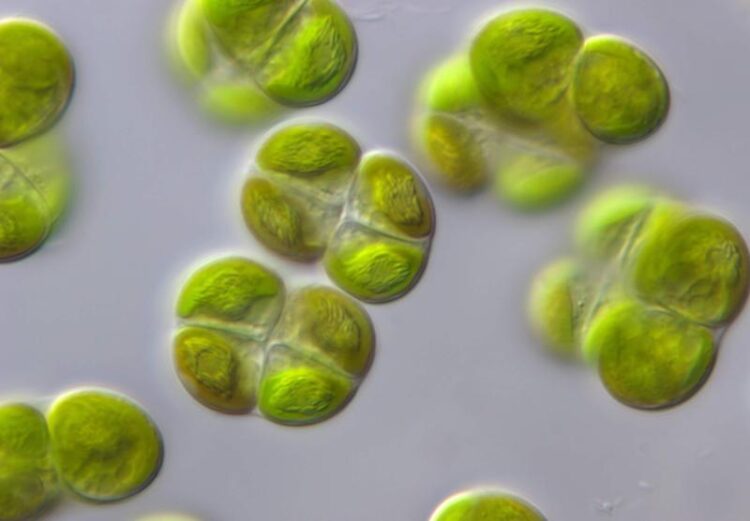Ancient lineage of algae found to include five “cryptic” species

One of the newly identified and described species, Chlorokybus cerfii sp. nov.
Credit: Dr Tatyana Darienko
Research team led by Göttingen University use genomic data to discover five species hidden in rare alga.
All land plants originated from a single evolutionary event when freshwater algae got a foothold on land, giving rise to an astonishing biodiversity of plants on earth. However, the group of algae that would later give rise to land plants had already been living and evolving in both freshwater and terrestrial habitats for over one billion years. There is a tiny group of these algae still living that are most distantly related to land plants. A team from the University of Göttingen honed in on one species of these rare algae, Chlorokybus,that forms “cell packages” and lives in wet soil and rock cracks. The researchers discovered that Chlorokybus contains not one, as previously thought, but at least five different species. The results were published in the Proceedings of the Royal Society B.
While small in number and vanishingly rare, these humble algae are valuable in terms of the evolutionary pathways they reveal. They diverged from land plants over a billion years ago, making them descendants of the ancient algal ancestor that also gave rise to modern land plants (and various other algae). The study started by tracking down and screening all known algae that can be assigned to Chlorokybus, including cultures from public algal collections and fresh samples obtained in Ukraine, Chile, and Costa Rica. “We even tried to collect Chlorokybus in the place where it was first described in the 1940s, living on a stone monument in the Schönbrunn Palace in Vienna. But we could not find it, probably because the monument had been recently restored,” says Dr Tatyana Darienko.
The researchers then conducted genetic analyses on the collected samples. The first analysis, based on just a few genes, showed marked genetic divergences among the various isolated algae. Hundreds of gene sequences obtained through large-scale genomic sequencing confirmed these unexpected results. This led the authors to recognize that there were actually five distinct species hiding under a single common name. These are called “cryptic species” to reflect the difficulty or impossibility of telling them apart by simple observation. In fact, traditional microscopy revealed no obvious differences between the five species. However, the genetic data told a different story: there were clear differences in gene expression, proving there were genetic differences among the species that are not observable to the naked eye.
Lead author Dr Iker Irisarri, University of Göttingen, explained, “The fact that these algae look so similar is a real surprise, given that some of these species might have diverged from each other over 70 million years ago! But the genetic data are unambiguous.” This study sheds new light into the biodiversity of a little studied algal group that occupies a key evolutionary position, being a close relative of land plants. This has important implications for our understanding of plant form and function. “Accounting for the real species diversity of this group of algae is paramount for ongoing comparative genomic studies that help explain the origin, adaptation and development of land plants and their algal relatives” says Professor Jan de Vries, University of Göttingen.
Original publication: Irisarri I et al. “Unexpected cryptic species among streptophyte algae most distant to land plants”, Proceedings Royal Society B 2021, DOI: 10.1098/rspb.2021.2168
Contact:
Professor Jan de Vries
University of Göttingen
Faculty of Biology and Psychology
Institute of Microbiology and Genetics
Department of Applied Bioinformatics
Goldschmidtstraße 1, 37077 Göttingen, Germany
Tel: +49 (0)551 39-13995
Email: devries.jan@uni-goettingen.de
www.uni-goettingen.de/en/613776.html
Journal: Proceedings of the Royal Society B Biological Sciences
DOI: 10.1098/rspb.2021.2168
Method of Research: Experimental study
Subject of Research: Cells
Article Title: Proceedings RoUnexpected cryptic species among streptophyte algae most distant to land plantsyal Society B
Article Publication Date: 24-Nov-2021
Media Contact
Melissa Sollich
University of Göttingen
melissa.sollich@uni-goettingen.de
Office: 49-551-392-6228
Original Source
All latest news from the category: Life Sciences and Chemistry
Articles and reports from the Life Sciences and chemistry area deal with applied and basic research into modern biology, chemistry and human medicine.
Valuable information can be found on a range of life sciences fields including bacteriology, biochemistry, bionics, bioinformatics, biophysics, biotechnology, genetics, geobotany, human biology, marine biology, microbiology, molecular biology, cellular biology, zoology, bioinorganic chemistry, microchemistry and environmental chemistry.
Newest articles

Innovative 3D printed scaffolds offer new hope for bone healing
Researchers at the Institute for Bioengineering of Catalonia have developed novel 3D printed PLA-CaP scaffolds that promote blood vessel formation, ensuring better healing and regeneration of bone tissue. Bone is…

The surprising role of gut infection in Alzheimer’s disease
ASU- and Banner Alzheimer’s Institute-led study implicates link between a common virus and the disease, which travels from the gut to the brain and may be a target for antiviral…

Molecular gardening: New enzymes discovered for protein modification pruning
How deubiquitinases USP53 and USP54 cleave long polyubiquitin chains and how the former is linked to liver disease in children. Deubiquitinases (DUBs) are enzymes used by cells to trim protein…



